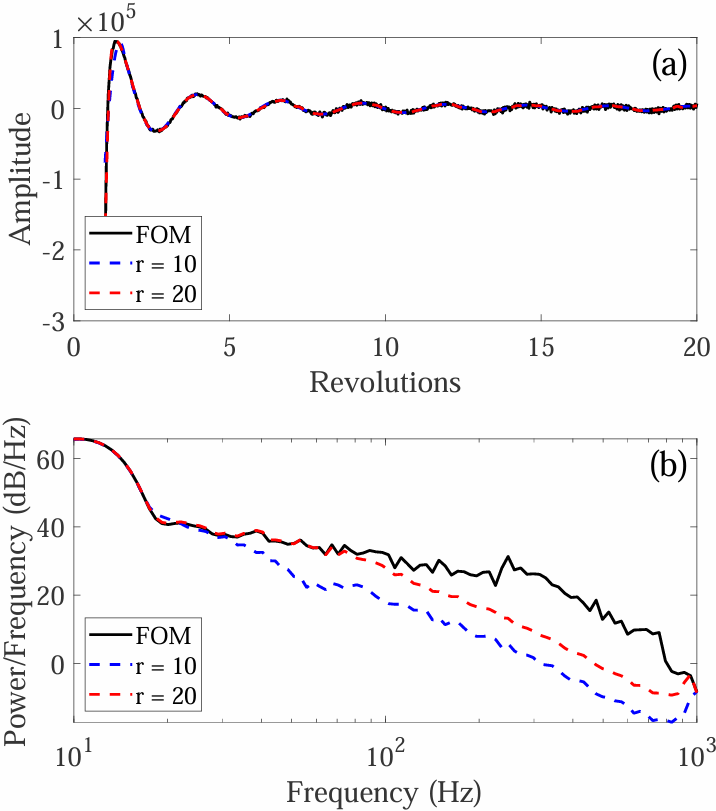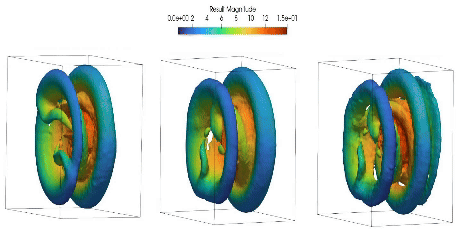Dynamic Mode Decomposition in Hydroacoustics
Project Snapshot
- Project Title: Applying Dynamic Mode Decomposition to Hydroacoustic Data of a Marine Propeller
- Type: Course Project - MECH 540F - Data-Driven Modeling (Link)
- Project Report: View Report (PDF)
- Concepts:
- Dynamic Mode Decomposition (DMD)
- Reduced Order Modeling (ROM)
- Maritime Noise Predictions
- Duration: Fall 2023
- Skills Developed:
- Data Generation: FLOWUnsteady, rVPM
- Data Manipulation & Analysis: NumPy, SciPy
- Data Visualization: Matplotlib, Seaborn
- Simulation Tools: PSU-WOPWOP, FW-H Acoustic Analogy
- Programming Languages: Python
Project Overview
1. Objective
To apply Dynamic Mode Decomposition (DMD) methodologies to hydroacoustic data of a marine propeller for efficient flow field reconstruction and accurate noise prediction.
2. Key Contributions
- Data-Driven Modeling: Employed DMD to capture spatiotemporal structures in the propeller wake flow field.
- Flow Field Reconstruction: Demonstrated the effectiveness of DMD in reconstructing velocity and vorticity fields with reduced computational resources.
- Acoustic Analysis: Utilized reconstructed flow fields for acoustic signal prediction, showcasing accurate noise level estimations.
Introduction and Background
1. Challenges in Maritime Noise Prediction
- Maritime transport significantly contributes to anthropogenic underwater noise, impacting marine life.
- Traditional high-fidelity simulations like LES are computationally intensive and impractical for real-time analysis or parametric studies.
2. Proposed Solution
- Develop a Reduced Order Model (ROM) using Dynamic Mode Decomposition to efficiently reconstruct flow fields.
- Leverage ROM for rapid and accurate prediction of propeller-induced noise, facilitating ship design optimization for noise reduction.
Methodology

Fig. 1: Flow Chart of the FOM/ROM Operation
1. Full Order Model (FOM)
- Simulation Tool: Used FLOWUnsteady, an open-source meshless Lagrangian solver based on the reformulated Vortex Particle Method (rVPM).
- Propeller Model: Simulated the DTMB 4381 marine propeller at 150 RPM over 20 revolutions.
- Data Generation: Generated high-fidelity flow field data for subsequent analysis.
2. Reduced Order Model (ROM) using DMD
- Data Organization: Collected snapshots of the flow field and organized them into matrices for DMD analysis.
- DMD Algorithm: Applied Singular Value Decomposition (SVD) to decompose the data and construct low-dimensional representations.
- Flow Field Reconstruction: Reconstructed velocity and vorticity fields using truncated modes (r = 10 and 20).

Fig. 2: Velocity and Vorticity Contours for FOM and DMD Reconstructions with r = 10 and 20
3. Dynamic Mode Decomposition Algorithm
Overview: DMD provides a linear approximation to nonlinear dynamical systems by decomposing data into modes with associated frequencies and growth rates.
- Constructed data matrices \( X \) and \( \dot{X} \) from snapshots.
- Computed the best-fit linear operator \( A \) minimizing \( ||\dot{X} - AX||_F \).
- Performed SVD truncation to obtain reduced-order representations.
- Derived DMD modes \( \Phi \) and eigenvalues \( \Lambda \) for flow reconstruction.
4. Acoustic Analysis
- Tonal Noise Calculation: Used Ffowcs Williams-Hawkings (FW-H) acoustic analogy via PSU-WOPWOP software.
- Broadband Noise Calculation: Applied Brooks, Pope, and Marcolini (BPM) method for broadband noise estimation.
- Signal Comparison: Compared pressure fluctuation signals from FOM and DMD ROM at a reference point 1m downstream.

Fig. 3: Acoustic Analysis: (a) Pressure Fluctuation Signals, and (b) Spectral Analysis
Results and Analysis
1. Flow Field Reconstruction
- Velocity and Vorticity Fields: DMD ROM accurately reconstructed flow fields with significant reduction in computational effort.
- Error Analysis: Observed higher errors at early revolutions due to transient effects; errors decreased as flow reached steady state.
- Mode Efficiency: Increasing the number of modes improved reconstruction accuracy, especially for complex vorticity dynamics.

Fig. 4: Vorticity Visualization of 3D Propeller
2. Acoustic Signal Prediction
- Pressure Signals: DMD ROM closely matched the FOM pressure fluctuation signals over time.
- Spectral Analysis: DMD accurately captured dominant low-frequency noise components with as few as 10 modes.
- High-Energy Components: Effective representation of primary noise features, indicating suitability for general acoustic characterization.
Conclusions
Summary of Findings:
- DMD-based ROM efficiently reconstructed complex flow fields of a marine propeller.
- Reconstructed flow fields enabled accurate prediction of hydroacoustic noise levels.
- Demonstrated potential for rapid and precise noise estimation in ship design optimization.
Future Work:
- Extend DMD analysis to various propeller designs for shape optimization challenges.
- Introduce geometric parameterization as an additional dimension in DMD for comprehensive analysis.
- Apply the methodology to voyage optimization problems requiring quick noise level computations.
Final Remarks
This project highlights the successful application of Dynamic Mode Decomposition in reducing computational complexity while maintaining high accuracy in flow field reconstruction and acoustic analysis. The approach offers significant advantages for marine engineering applications, particularly in the design and optimization of quieter, more environmentally friendly ships.